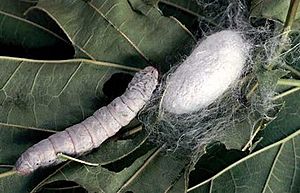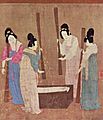Sericulture facts for kids
Sericulture, also known as silk farming, is how we make silk fibers. It all begins with raising special insects called silkworms. These worms create the fibers, which are then collected and processed. These silk fibers are twisted together to make strong silk thread. This thread can then be made into silk yarn or woven into beautiful silk cloth (fabric).
How Silk is Made
The Silkworm Life Cycle
Making silk involves several important steps, following the life cycle of the silkworm:
- First, the adult silk moth lays thousands of tiny eggs.
- These eggs hatch into small larvae, which are like caterpillars. We call these young caterpillars "silkworms."
- The silkworms eat a lot of mulberry leaves. They grow bigger and shed their skin several times.
- Once they are big enough, the silkworm starts to make a net to hold itself.
- It moves its head from side to side in a figure-eight shape. As it moves, it lets out a special liquid from its mouth.
- This liquid turns into a solid silk fiber as soon as it touches the air.
- The silkworm keeps spinning until it has completely covered itself in a protective case called a cocoon. This takes about two or three days. A single silkworm can spin about one mile (1.6 kilometers) of silk fiber!
Harvesting the Silk
After the cocoons are made, the next steps are about getting the silk:
- The cocoons are carefully collected. To get the silk, the cocoons are boiled. This also stops the silkworm inside (which is now a pupa) from breaking the silk thread when it tries to come out.
- Workers then gently brush the undamaged cocoons to find the very end of the silk fiber.
- Once the end is found, the silk fibers are carefully unwound and wound onto a reel.
Each cocoon has only a small amount of usable silk. Because of this, it takes about 2,500 silkworms to make just one pound (about 0.45 kg) of raw silk. One cocoon can give about 1,000 yards (914 meters) of silk fiber. The silk at this stage, before it's made into fabric, is called "raw silk." A single silk thread is usually made up of as many as 48 individual silk fibers twisted together.
Images for kids
-
Court Ladies Preparing Newly Woven Silk by Emperor Huizong of Song
See also
 In Spanish: Sericicultura para niños
In Spanish: Sericicultura para niños













